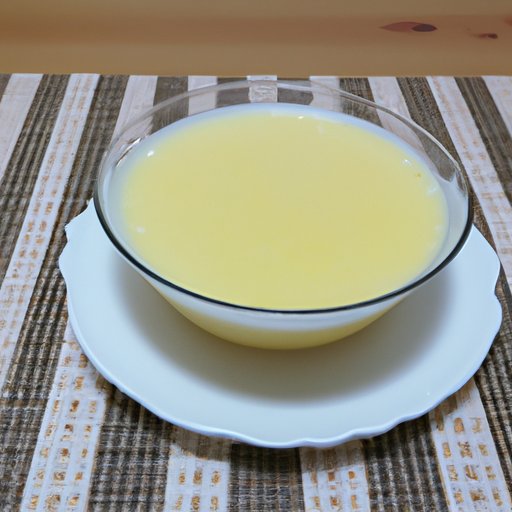Introduction
Custard is a popular dessert enjoyed all over the world, and for a good reason. It is rich, creamy, and can be enjoyed in several different ways – on its own, with fruits, or as a filling in baked goods. In this article, we will provide a comprehensive guide to making perfect custard from scratch. Each section will cover different aspects of custard, including the recipe, tips, health benefits, variations, science, history, and uses. Let’s get started!
Step-by-step recipe
Making custard from scratch is not as complicated as it may seem. To make perfect custard, you will need the following ingredients:
- 2 cups of milk
- 4 egg yolks
- 1/4 cup of sugar
- 2 tablespoons of cornstarch
- 1 tsp of vanilla extract
Here are the step-by-step instructions for making custard:
- In a medium saucepan, heat the milk until hot but not boiling. Remove from heat.
- In a separate mixing bowl, whisk together the egg yolks and sugar until the mixture is light and frothy. Add cornstarch and whisk until well-combined.
- Slowly pour a little bit of the hot milk into the egg mixture, whisking continuously to prevent curdling.
- Pour the egg mixture back into the saucepan containing the hot milk. Turn the heat back to medium and keep whisking constantly until the custard thickens and coats the back of a spoon.
- Remove the pan from the stove and mix in the vanilla extract until well combined.
- Allow the custard to cool down before serving or refrigerate until your ready to serve.
Tips for perfect custard
Here are some tips for ensuring that your custard turns out perfectly every time:
- Make sure that the cornstarch is completely dissolved in the egg mixture to avoid lumps in the final product.
- Whisk the egg mixture continuously while adding the hot milk to prevent the eggs from curdling. If the eggs do start to curdle, strain the mixture through a fine-mesh sieve and continue with the recipe.
- When cooking the custard, use low heat and continuously stir it to prevent scorching it at the bottom of the pan.
- Do not let the custard boil, as this can cause it to break, resulting in a watery mixture.
- Allow the custard to cool down before serving to enhance its flavor and consistency.
Health benefits of eating custard
Custard is a snack that can provide you with essential nutrients, such as protein, calcium, and vitamins D and B12.
The egg yolks found in custard are rich in protein and help in building muscle and promoting healthy hair and skin. Additionally, they are an important source of vitamin B12, which is essential for nerve function and red blood cell production. The milk used is a great source of calcium, which promotes strong bones and teeth. Vitamin D assists in the absorption of calcium, making it easier for your body to benefit from the milk’s nutrients.
Variations of custard
Custard can be flavored in various ways, beyond the classic vanilla custard. Here are some variations that you can try:
- Chocolate custard – Add 1/4 cup cocoa powder to the recipe for chocolate-flavored custard.
- Fruit custard – Fold fresh fruits like chopped apples or berries or canned pineapple to make a fruit custard.
- Nut-infused custard – Add finely ground nuts like almonds or hazelnuts to the recipe.
The science of custard
The chemistry behind custard involves the eggs, specifically the proteins and the fat globules found in the yolks. When the eggs are mixed with milk and sugar, they act as a thickener and help the mixture to congeal. The protein in the yolks helps stabilize the emulsion, which helps it to stay together instead of separating into watery solids and liquids.
The history of custard
Custard has been enjoyed for centuries. The oldest known recipe for custard dates back to the 14th century in England, where it was a popular dessert during the Middle Ages. Over time, custard has evolved with different regions putting their own unique spin on the recipe. For example, Portuguese egg tarts are made with a custard filling flavored with cinnamon, while French crème brûlée is creation of rich custard topped with caramelized sugar.
Uses for custard
Custard can be used in a variety of different ways beyond being a standalone dessert. Here are some creative ideas:
- Custard filling can be used in cakes, cupcakes, pies, and other baked treats.
- Drizzle custard over fresh fruit or pie for an extra creaminess to your dessert.
- Custard can be layered with pound cake and fruit for a trifle.
- Homemade ice cream can be made by mixing custard and milk and freezing them in an ice cream maker.
Conclusion
Custard is a popular and versatile dessert that can be made in various ways to suit different preferences. In this article, we have shared a comprehensive guide on how to make perfect custard from scratch. We have also covered tips for making the best custard, the health benefits of eating custard, variations of custard, the science and history of custard as well as its different uses.
